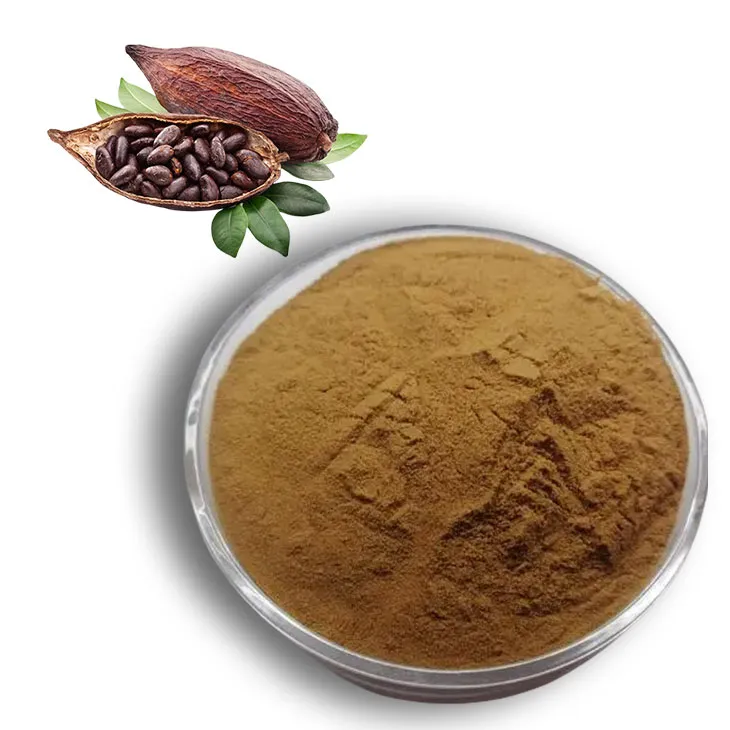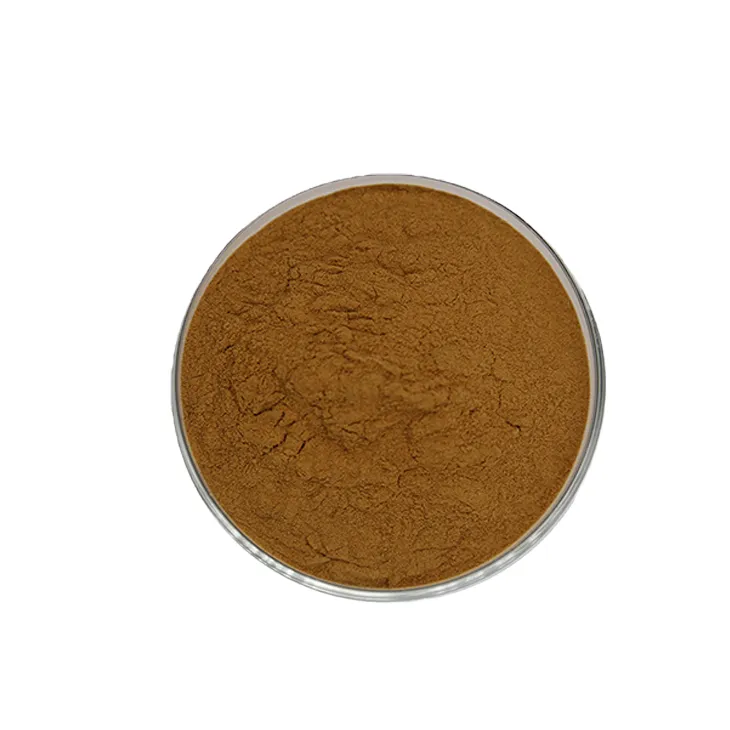- 0086-571-85302990
- sales@greenskybio.com
The process of extracting cocoa polyphenols from cocoa extract.
2024-11-27

1. Introduction
Cocoa polyphenols are a group of bioactive compounds found in cocoa beans. These compounds have been associated with numerous health benefits, such as antioxidant, anti - inflammatory, and cardioprotective properties. Extracting cocoa polyphenols from Cocoa Extract is an important process in the food and pharmaceutical industries. This article will explore the different methods of extraction, including microwave - assisted extraction and enzymatic extraction, and how factors such as temperature, pressure, and extraction time impact the yield and quality of cocoa polyphenols.

2. Cocoa Extract: A Rich Source of Polyphenols
Cocoa Extract is obtained from cocoa beans, which are the seeds of the Theobroma cacao tree. Cocoa beans are rich in polyphenols, particularly flavonoids such as catechins, epicatechins, and procyanidins. These polyphenols are responsible for the bitter taste of dark chocolate and are also the source of its potential health benefits.

3. Methods of Cocoa Polyphenol Extraction
3.1 Microwave - Assisted Extraction
Microwave - assisted extraction (MAE) is a relatively new extraction technique that has been applied to the extraction of cocoa polyphenols. The principle behind MAE is the use of microwave energy to heat the extraction solvent and the cocoa extract, which in turn increases the mass transfer rate of the polyphenols from the solid matrix to the solvent.
The process of MAE typically involves the following steps:
- Preparation of the cocoa extract: The cocoa beans are first roasted, ground, and defatted to obtain a cocoa extract.
- Mixing with the extraction solvent: The cocoa extract is mixed with an appropriate extraction solvent, such as ethanol or water - ethanol mixtures.
- Exposure to microwave energy: The mixture is placed in a microwave - transparent vessel and exposed to microwave energy for a specific period of time. The microwave power, irradiation time, and solvent - to - sample ratio are important parameters that need to be optimized to achieve maximum extraction efficiency.
- Separation and purification: After the microwave treatment, the mixture is filtered to separate the liquid extract from the solid residue. The liquid extract may then be further purified using techniques such as chromatography or membrane filtration to obtain a pure cocoa polyphenol extract.
One of the advantages of MAE is its rapid extraction speed. Compared to traditional extraction methods, MAE can significantly reduce the extraction time, which is beneficial for industrial - scale production. Additionally, MAE can also improve the extraction yield and quality of cocoa polyphenols by selectively heating the target compounds and minimizing the degradation of heat - sensitive polyphenols.
3.2 Enzymatic Extraction
Enzymatic extraction is another method that has been used for the extraction of cocoa polyphenols. This method involves the use of enzymes to break down the cell walls of the cocoa beans and release the polyphenols into the extraction solvent.
The general procedure for enzymatic extraction is as follows:
- Enzyme selection: Different enzymes can be used for enzymatic extraction, such as cellulases, pectinases, and proteases. The choice of enzyme depends on the composition of the cocoa beans and the target polyphenols.
- Preparation of the enzyme solution: The selected enzyme is dissolved in an appropriate buffer solution to prepare an enzyme solution with a specific concentration.
- Mixing with the cocoa extract: The cocoa extract is mixed with the enzyme solution and incubated at a specific temperature and pH for a certain period of time. During the incubation, the enzymes act on the cell walls of the cocoa beans, breaking them down and facilitating the release of polyphenols.
- Termination of the enzymatic reaction: After the incubation, the enzymatic reaction is terminated by heating or adjusting the pH. The mixture is then filtered to separate the liquid extract from the solid residue.
- Further purification: Similar to MAE, the liquid extract may be further purified using chromatography or other techniques to obtain a pure cocoa polyphenol extract.
Enzymatic extraction has several advantages. It is a mild and environmentally friendly extraction method that can avoid the use of harsh chemicals. Moreover, enzymatic extraction can improve the extraction yield by specifically targeting the cell wall components and releasing the trapped polyphenols. However, the cost of enzymes and the complexity of the enzymatic reaction conditions are some of the challenges associated with this method.

4. Factors Affecting the Yield and Quality of Cocoa Polyphenols
4.1 Temperature
Temperature is an important factor that affects the extraction of cocoa polyphenols. In both MAE and enzymatic extraction, the appropriate temperature needs to be maintained to ensure optimal extraction efficiency.
In MAE, increasing the temperature can enhance the mass transfer rate of polyphenols, but too high a temperature may lead to the degradation of heat - sensitive polyphenols. Therefore, a balance needs to be struck between extraction speed and polyphenol stability. For example, in some studies, an optimal temperature range of 50 - 70°C has been reported for MAE of cocoa polyphenols.
In enzymatic extraction, the temperature affects the activity of the enzymes. Each enzyme has an optimal temperature range at which it exhibits maximum activity. For example, cellulases typically have an optimal temperature range of 40 - 60°C. Deviating from this optimal temperature can reduce the enzyme activity and consequently the extraction yield of polyphenols.
4.2 Pressure
Pressure can also play a role in the extraction of cocoa polyphenols, especially in MAE. In a microwave - assisted extraction system, the application of pressure can help to increase the boiling point of the extraction solvent, which in turn allows for a higher extraction temperature without solvent evaporation. This can potentially improve the extraction yield of polyphenols.
However, excessive pressure can also have negative effects. It may cause the breakdown of the extraction equipment or lead to the formation of unwanted by - products. Therefore, the appropriate pressure needs to be carefully controlled during the extraction process.
4.3 Extraction Time
Extraction time is another crucial factor. In MAE, increasing the extraction time can initially increase the yield of cocoa polyphenols as more polyphenols are transferred from the solid matrix to the solvent. However, after a certain point, further increasing the extraction time may not lead to a significant increase in yield and may even cause the degradation of polyphenols due to over - exposure to heat or microwave energy.
In enzymatic extraction, the extraction time is related to the enzyme activity and the breakdown of the cell walls. Insufficient extraction time may result in incomplete release of polyphenols, while excessive extraction time may not be necessary and may increase the cost of the process.

5. Comparison of Different Extraction Methods
Both microwave - assisted extraction and enzymatic extraction have their own advantages and disadvantages in terms of cocoa polyphenol extraction.
- Microwave - assisted extraction:
- Advantages: Rapid extraction speed, high extraction yield, and can be easily scaled up for industrial production.
- Disadvantages: Requires specialized microwave equipment, and high temperatures may cause degradation of some heat - sensitive polyphenols.
- Enzymatic extraction:
- Advantages: Mild extraction conditions, environmentally friendly, and can specifically target cell wall components for improved yield.
- Disadvantages: High cost of enzymes, complex reaction conditions, and relatively long extraction time.
6. Conclusion
The extraction of cocoa polyphenols from cocoa extract is a complex process that is influenced by various factors such as the extraction method, temperature, pressure, and extraction time. Microwave - assisted extraction and enzymatic extraction are two important methods that offer different advantages and disadvantages. By carefully optimizing these factors, it is possible to achieve high - quality cocoa polyphenol extracts with high yields, which can be further utilized in the food, pharmaceutical, and cosmetic industries for their potential health benefits and functional properties.
FAQ:
1. What are the main advantages of microwave - assisted extraction in cocoa polyphenol extraction?
Microwave - assisted extraction has several main advantages. Firstly, it can significantly reduce the extraction time compared to traditional extraction methods. The microwave energy can rapidly heat the cocoa extract, facilitating the release of polyphenols. Secondly, it can often lead to a higher yield of cocoa polyphenols. The selective heating effect of microwaves can target the components containing polyphenols more effectively, thus extracting more polyphenols. Additionally, it may also help in maintaining the quality of the extracted polyphenols as the shorter extraction time may reduce the degradation of polyphenols.
2. How does enzymatic extraction work in the context of cocoa polyphenol extraction?
Enzymatic extraction involves the use of specific enzymes. In cocoa polyphenol extraction, enzymes are added to the cocoa extract. These enzymes break down the cell walls and other complex structures in the extract that may be holding the polyphenols. For example, certain enzymes can hydrolyze polysaccharides or proteins that are associated with the polyphenols. This breakdown makes it easier for the polyphenols to be released into the extraction solvent, thereby increasing the extraction efficiency.
3. What is the role of temperature in cocoa polyphenol extraction?
Temperature plays a crucial role in cocoa polyphenol extraction. An appropriate temperature can enhance the solubility of polyphenols in the extraction solvent. At a higher temperature, the kinetic energy of the molecules in the cocoa extract and the solvent increases, which promotes the diffusion of polyphenols from the extract into the solvent. However, if the temperature is too high, it may lead to the degradation of polyphenols, reducing their quality. Therefore, a balance needs to be struck to optimize the extraction process in terms of both yield and quality.
4. How does pressure affect the extraction of cocoa polyphenols?
Pressure can influence the extraction of cocoa polyphenols in multiple ways. Increasing the pressure can enhance the penetration of the extraction solvent into the cocoa extract. This is because higher pressure can force the solvent to enter the pores and spaces within the extract more effectively, reaching the polyphenols that are trapped inside. However, extremely high pressure may also cause some unwanted chemical reactions or physical changes in the extract or the polyphenols themselves. So, like temperature, the pressure needs to be carefully controlled to achieve the best extraction results.
5. How can the extraction time be optimized for cocoa polyphenol extraction?
The optimization of extraction time depends on several factors. Firstly, the nature of the extraction method used (such as microwave - assisted or enzymatic extraction) affects it. For example, microwave - assisted extraction generally requires a shorter time compared to some traditional methods. Secondly, factors like temperature and pressure also play a role. If the temperature and pressure are set at levels that promote rapid extraction, the extraction time can be reduced. However, it is important to ensure that sufficient time is given to extract an adequate amount of polyphenols without causing degradation. This often requires experimental determination through a series of trials to find the optimal time for a specific extraction setup.
Related literature
- Advances in Cocoa Polyphenol Extraction Techniques"
- "The Impact of Extraction Parameters on Cocoa Polyphenol Quality"
- "Microwave - Assisted Extraction of Bioactive Compounds from Cocoa: A Review"
- "Enzymatic Extraction for High - Quality Cocoa Polyphenol Production"
- ▶ Hesperidin
- ▶ Citrus Bioflavonoids
- ▶ Plant Extract
- ▶ lycopene
- ▶ Diosmin
- ▶ Grape seed extract
- ▶ Sea buckthorn Juice Powder
- ▶ Fruit Juice Powder
- ▶ Hops Extract
- ▶ Artichoke Extract
- ▶ Mushroom extract
- ▶ Astaxanthin
- ▶ Green Tea Extract
- ▶ Curcumin
- ▶ Horse Chestnut Extract
- ▶ Other Product
- ▶ Boswellia Serrata Extract
- ▶ Resveratrol
- ▶ Marigold Extract
- ▶ Grape Leaf Extract
- ▶ New Product
- ▶ Aminolevulinic acid
- ▶ Cranberry Extract
- ▶ Red Yeast Rice
- ▶ Red Wine Extract
-
Sophora Japonica Flower Extract
2024-11-27
-
Longan Extract
2024-11-27
-
Rose Hip Extract
2024-11-27
-
Echinacea Extract
2024-11-27
-
Jujube Extract
2024-11-27
-
Lemon Balm Extract
2024-11-27
-
Pine bark Extract Powder
2024-11-27
-
Citrus bioflavonoids
2024-11-27
-
Dan Shen Root Extract/Salvia Root Extract
2024-11-27
-
Cassia Seed Extract
2024-11-27





















